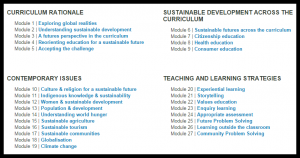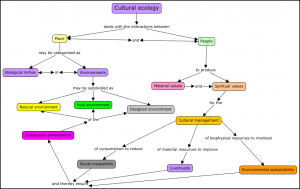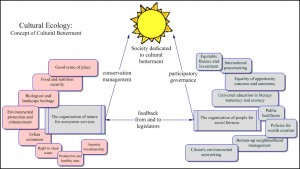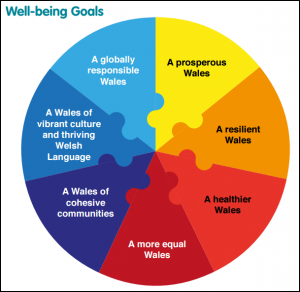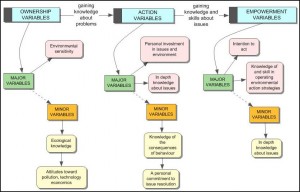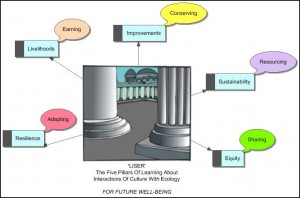“The study of futures is intellectually stimulating and seeks to empower students. It draws on the innate capacity of the human mind to engage in foresight, or futures thinking enhanced by concepts, tools and techniques. When this enhanced capacity to engage with ‘the future’ is implemented in specific areas … Futures can contribute substantially to social and economic well-being. Students … [can] be encouraged to transform their view of the world. As they develop informed foresight about the 21st century they may experience many shifts of value, focus and attitude and they should discover that most fears, negative attitudes and ‘doomsday’ images of the future rest on misperceptions. In learning how present actions will shape future consequences, students gain access to new sources of understanding and action”.
Source: Slaughter, R. (2008) Futures Education: Catalyst for our Times, Journal of Futures Studies, 12(3), pp.15-30
1 Educational additions to subject-based curricula
“Learning for the future’ was the title of a document adopted at the sixth meeting of the United Nations steering committee on education for sustainability in 2011. The context was that education should play a more relevant role in enabling people to live together in ways that take no more resources from Earth than it can regenerate and share equally.
The problem is that subject-based education contributes to thinking of Earth as an infinite resource. This happens through a lack of opportunity for classroom learners to question their own lifestyles and their demands on systems and structures that are often far away but promote and support those lifestyles. In other words, these old education systems designed to initiate an industrial revolution fail to position today’s learners’ own thinking and actions in relation to what is demanded to maintain a post-industrial society.
In particular, schools fail to prepare their pupils for this future because they reproduce unsustainable economic models and practices that dominate day to day living. Therefore the recasting of learning for sustainable lifestyles calls for the reorientation of education, backed by concrete practical experiences that are relevant to the long term resilience of communities served by the schools.
This will only be achieved by developing the capacity for cross-curricular critical reflection and systems thinking with regards to three vital dimensions of learning for the future, namely;
- Learning from the past;
- Inspiring engagement in the present;
- Exploring alternative futures.
Such learning involves applying the basics of systems thinking to understand the functions of social and economic systems and how they may be interrelated across professional boundaries. It should explore new economic transactions, such as ‘timebanking. It should highlight the interdependent nature of relationships within and between present generations as well as those between rich and poor and between humans and nature. The learners’ personal worldviews and their cultural assumptions should be questioned, whilst seeking to understand those of others. Above all, education for sustainability should clarify the connections between sustainable futures and the future ways in which we will have to think, live and work differently, as politically engaged citizens, consumers and long lived individuals requiring increasing medical care. These are the global realities for educating future generations.
2 The UNESCO on line teacher training modules
Because education is entrenched for the perpetuation of subject-based professions, including the teaching profession itself, there is no way that the backwards facing Western system can be overturned. The best that can be expected is that the holistic futuristic principles of education for sustainability can be offered in parallel as a collection of multimedia resources for lifelong learning. In the introduction to its on line multimedia-based Internet programme for teaching teachers how to promote learning for a sustainable future , UNESCO points out its numerous advantages of multimedia in teacher education. For example:
- the information contained on the Internet is unlimited and evolving. It is up to date, inexpensive to obtain, and searchable for building personal bodies of knowledge.
- it is democratic as it reflects the view of many authors and sources of authority.
- bespoke multimedia professional teacher education can be highly interactive and engaging through the use of animation, audio and video files, games and on line discussions. All these can be undertaken at any time and at any place and without the need for an expert workshop facilitator.
Thereby the the ‘medium’ for learning is a part of the ‘message’. In order to achieve this goal, the learning experiences have to exemplify three principles of effective professional development:
- academic rigour,
- experiential learning
- and reflection.
Academic rigour
Teaching and learning for a sustainable future requires up-to-date knowledge about key issues related to global realities and sustainable development themes from many disciplines. Since it is produced by an international body the UNESCO programme has been developed through extensive consultation, review and evaluation and is as free as possible from cultural or other biases. Links to numerous Internet sites also provide multiple perspectives on a variety of topics and can enhance access to information and critical thinking. The on line learning experiences also integrate contemporary thinking in educational circles on curriculum reform and effective teaching and learning strategies. The modules illustrate the following blueprint for building an education programme for living sustainably.
Experiential learning
All the modules for on line learning should be based upon an experiential learning process that:
- invites users to analyse and interpret information in a variety of forms (e.g. text, tables, diagrams, computer games, and linked WWW-sites);
- allows reviews of new knowledge in the light of current understandings;
- allows reflection upon and generalises from learning experiences;
- promotes skills in a wide variety of teaching and learning strategies;
- encourages learners to adapt and apply new ideas and skills to practical educational tasks.
Reflection
Reflection is integral to the professional development experiences. A deepening appreciation of topics is encouraged by the use of what UNESCO describes as a ‘Learning Journal’. Answering questions in the ‘Learning Journal’ is a practical way of learning. It also provides a record of what has been learned, ideas and plans for applying these ideas in local situations, and opportunities for on-going professional reflection. Some questions in the Learning Journal may also be used as starting points for student learning material. Indeed, the teacher training modules as a whole can be accessed directly by learners at any level with an Internet connection.
Fig 1 UNESCO teacher training modules
An important criticism of the modules offered in the UNESCO education resource is that they represent an arbitrary collection of issues (Fig 1), with no hierarchical categorisation or binding story. This probably reflects the inputs from a ‘committee’ of experts.
3 Cultural ecology
Cultural ecology emerged in the 1980s from relative isolation in ethnography. It was given the name ‘natural economy’ and promoted as a subject dealing with world development for international clients of the University of Cambridge General Certificate of Education. If it was adopted by a school, it was through the international baccalaureate, and replaced, or was an alternative to, geography and/or biology.
Cultural ecology was further developed, with a sponsorship from the European Union, by the Natural Economy Research Unit in the National Museum of Wales at Cardiff, with inputs from teachers and their students sponsored by the Countryside Council for Wales and Chevron/ Texaco. It was delivered throughout Europe as part of the European Satellite Education programme.
Cultural ecology presents two sides of the story of global economic development. The latter has taken place by the ‘unlocking of nature’, at first by self-sufficient groups in bands, and tribes. Now it involves networks of nations interlocked in competitive industrial mass production and the movement of resources and goods rapidly over vast global distances, measured in hours or days. This process has taken place not by biological evolution, but by inventions, which, from age to age, have created an economic system, which defines betterment as year on year monetary growth. This expansion began with the application of ideas about the living world, which produced the hunter and the forager and led to fire and water being harnessed as physical aids for comfort and to lighten labour.
Looking to history, economic development has taken place by behaviours that arose early in the simplest human cultures from basic and specific faculties. From these beginnings, human production, through inventions to exploit natural resources, has occurred by the political organisation of groups of people for production; the so-called political economies. This has, in the long run, inevitably stimulated demand for more and more goods and services. By 1750 water had become the engineer’s element that set off the British industrial revolution. The water wheel was the first multipurpose machine for the new manufacturies. Increased exploitation of natural resources through mass production and increased demand for products had an increasing environmental impact. An ‘age of plenty’ for a few had begun.
So great is the current impact of mass production that it is evident that conservation of natural resources, which has always been part of indigenous cultures, has to be built into generally acceptable international strategies for economic development and long-term survival of industrial cultures. The first ‘minimal impact of cultural ecology’ was about hunting and gathering. The future maximal impact is about sustainability of industrialism.
Global industrialism is a scientific civilisation in which knowledge and its integrity supplies a set of educational principles according to which we shape our conduct. Citizens in most industrial countries are educated to share a belief in progress, faith in the steady increase of material affluence, which unfortunately is equated with progress, and belief in the necessity and goodness of economic growth. Other central features of the industrial educational system include:
- high values placed on work, the nuclear family, and career-oriented formal education;
- a strong faith in the efficacy of science and technology (as opposed to religion) to solve problems;
- and a view of ‘Nature’ as something to be subdued by humankind.
These values led to the development of educational systems in which subjects were built according to the knowledge required to educate the specialists who were to carry forward this exploitative culture.
A new educational map is needed to replace the fragmented one that has been shaped by the industrial revolution and that is now leading inexorably toward the destruction of industrial society. Earth cannot supply sufficient resources for all to realise the Western dream. Industrial mankind must remake its culture and direct its future cultural evolution. A rationally controlled technology does give us a means of survival for ourselves and many generations to come, although it must be supplemented by a social technology that encourages people to value and reward ecologically sound behaviour. A new economics must bottom out with zero growth and equitable wealth. Humanity must respond to survival imperatives with meaningful social action.Culture must again become an ally, rather than an enemy, in realising the sensible strategies for survival that were set out as long ago as the 1992 Rio Environmental Summit.
This concept map of cultural ecology (Fig 2) maps the undercurrents of knowledge about people and environment that flow between and into conventional subjects. It is an overview of the integration of knowledge required to produce a story of humankind’s progress into the future. This is an holistic view of the topics that have to be brought together to explain human cultural evolution and is needed to develop managerial operations so the international community can balance its use of natural resources in relation to their continued availability. Subjects have been replaced by topics. Topics are the links between knowledge and action and are guideposts for a sustainable society. In the mind map of cultural ecology it will be seen that traditional subjects, which are designed to produce specialists, are to be found three to four levels deep.
The concept map of cultural ecology tells the story of the fundamental interactions between place and people. Place may be categorised as biological niches or environments. Environments may be subdivided as built environment, the natural environment and designed environment.
Cultural ecology deals with the interactions between people and place to produce material values and spiritual values for the cultural management of consumerism to reduce social inequalities, of material resources to improve livelihoods and biophysical resources to maintain environmental sustainability. These managerial actions thereby ensure sustainable development.
Fig 2 Concept map of cultural ecology
As a cross curricular storyline, cultural ecology maps the flows of materials from the stars to the body fluids of plants, animals and microbes. The starting point has to be a mind map which delineates the relationships as a panel of nested topics, and as a topic mind map and a concept map. Each topic has text notes. The notes are concise statements of the main elements to be considered for expansion with links to websites resources .
The two flows of ideas about cultural ecology begin with the major topics of ‘exploiting resources’ and ‘conserving resources’.
Exploiting resources
Viewed through the human economic system and its consequences, one set of second-level topics represents the exploitation of natural resources governed by people’s ideas about human production. This starts with knowing how to tap resources for making goods.. When basic survival needs have been met, ‘making things’ is accelerated by ever demanding markets. Demand is now so great by all nations across the world that it is impacting on the limited stocks and the planet’s finite space, is producing changes in culture, society and environment. The stocks and flows of nature’s production represent the intrinsic organisation for producing the resources we loosely call ‘natural’, and are the sources of ecosystem goods and services. Humankind has grown by spreading to find these services and current migration out of Africa is an example of this age old imperative.
Conserving resources
Conservation of natural resources takes place around ideas about how to cope with the impact of human production through concepts of culture, society and environment. The aim is to sustain production from generation to generation by developing a global culture committed to conservation strategies and action plans to turn these strategies into operations. The planned objectives of action plans have to be met through, outcome- based conservation management systems with monitored performance indicators.
But following these flow of ideas, and agreeing with the conclusion that the present cultural attitudes towards the dominance of exploitation have to be moderated by conservation management in home and community, is not enough. There has to be the application of a paradigm for living in an overcrowded world. If each person fails to see, feel and act in relation to the long-term consequences of what he or she is doing, all will be lost. In the end, each person must come, through education, to feel responsible for the present and future welfare of all humankind. Education can only become relevant to future needs when its content corresponds to, or gives valid and acceptable guidance for, needs to deal with problems and issues of global consumerism.
Designing a new culture for living sustainably means adopting an activist attitude against continuous growth of a monetary economy, and passive acquiescence to the results of technology. But most importantly it means actively intervening to modify norms, values, and institutions to bring them into line with the physical and biological constraints of the ecological economy within which humanity must operate.
The entire world society must soon reach a consensus on what is meant by a livable world and must cooperate in using science, technology, and social institutions to construct that world, rather than forcing people to conform to a world shaped by these forces out of control. The overall aim is social betterment, which involves the organisation of nature to maintain ecosystem services through democratic participatory governance, also known as co-production, to manage these services where the flows of minerals and carbon are the real currency (Fig 3)
Fig 3 Relationships between conservation management and participatory governance for cultural betterment.
As an indication of the popularity of cultural ecology as a useful cross-curricular educational framework, currently the natural economy.info web site receives over a million unique hits a year. Its wikis, such as educationforsustainability, have around two hundred international visitors a day. Also, over 60,000 people are registered readers of its blog.
4 Governance for sustainability (the Welsh model)
In 2015 the Welsh government passed the ‘Well-being of Future Generations Act’. Now, by law, every aspect of governance in Wales has to comply with the principle of sustainable development. The Act makes provisions requiring public bodies;
- to do things in pursuit of the economic, social, environmental and cultural well-being of Wales in a way that accords with the sustainable development principle;
- to report on such action;
- to establish a Commissioner for Future Generations to advise and assist public bodies in doing things in accordance with this Act;
- to establish public services boards in local authority areas;
- to make provision requiring those boards to plan and take action in pursuit of economic, social, environmental and cultural well-being in their area; and for connected purposes.
Sustainable development In the Act, means the process of improving the economic, social, environmental and cultural well-being of Wales by taking action, in accordance with the sustainable development principle, aimed at achieving seven wellbeing goals (Fig 4).
Fig 4 Well-being goals
In summary, the Act places a well-being duty on public bodies each of which must carry out sustainable development. The action a public body takes in carrying out sustainable development must include—
(a) setting and publishing objectives (“well-being objectives”) that are designed to maximise its contribution to achieving each of the well-being goals,
and (b) taking all reasonable steps (in exercising its functions) to meet those objectives
Any reference to a public body doing something “in accordance with the sustainable development principle” means that the body must act in a manner which seeks to ensure that the needs of the present are met without compromising the ability of future generations to meet their own needs.
The Act will be operated through local public service boards who will, in consultation with communities, prepare action plans with measurable objectives for improving well-being. The outcomes of the plans will be monitored against national performance indicators.
In order to behave in that manner, a public body must take account of the following things;
(a) the importance of balancing short term needs with the need to safeguard the ability to meet long term needs, especially where things done to meet short term needs may have detrimental long term effects;
(b) the need to take an integrated approach, by considering how;
(i) the body’s well-being objectives may impact upon each of the well-being goals;
(ii) the body’s well-being objectives impact upon each other or upon other public bodies’ objectives, in particular where steps taken by the body may contribute to meeting one objective but may be detrimental to meeting another;
(c) the importance of involving other persons with an interest in achieving the well-being goals and of ensuring those persons reflect the diversity of the population of;
(i) Wales (where the body exercises functions in relation to the whole of Wales), or
(ii) the part of Wales in relation to which the body exercises functions;
(d) how acting in collaboration with any other person (or how different parts of the body acting together) could assist the body to meet its well-being objectives, or assist another body to meet its objectives;
(e) how deploying resources to prevent problems occurring or getting worse may contribute to meeting the body’s well-being objectives, or another body’s objectives.
Boards are required to improve the well-being of their area by contributing to the well-being goals, which they are to do by assessing well-being in their area, setting local objectives designed to maximise the board’s contribution (within its area) to the achievement of the well-being goals and taking steps to meet those objectives.
The Act establishes the office of Future Generations Commissioner for Wales and provides for the Commissioner to promote the needs of future generations by monitoring and reporting on the extent to which the public bodies are setting and seeking to meet their well-being objectives in accordance with the sustainable development principle. The Commissioner will carry out reviews of public bodies with a panel of advisers.
Wales is the first nation to enshrine the principle of sustainable development in law and establish mechanisms to plan for the well-being of future generations.
5 Rescue mission; an international action-education model
An international youth group came together after the 1992 Rio Environmental Summit to turn the summit’s strategic plan for the 21st century, ‘Agenda 21’ into a user-friendly booklet for young people. Their aim was to activate global youth to change their behaviour for a sustainable future. The group was funded by the UN and their booklet, entitled ‘Rescue Mission Planet Earth’, was published on International Earth Day in 1994.
Two years earlier Hungerford and Volk had published their research on environmental education as a practical process, demonstrating that people tend to do what they believe they are capable of and what can cause an intended effect. When facing huge environmental issues (e.g. climate change), people simply do not believe they can do anything to change the situation. Moreover, such a feeling is often connected with personal traits. Some people do not believe they are able to change much in their lives. They believe that many things they experience are influenced by a chance or by the will of someone else. The lack of belief in their own capacity to change things undermines their willingness for pro-environment behaviour. To change this attitude, people need to experience a success they can clearly match with their own effort. Being only informed about environmental issues, they often say something like, ‘OK, but what can I do to help…someone else should solve the problem’. Such kind of ‘awareness based’ education programmes often deepen their frustration and apathy. Because of this, a well-working environmental education programme should be ‘action-based’. It means learners at any level should not only be informed about an issue but they should be provided with an opportunity to deal with that issue; to act and to see a change.
Experience of a success might have two positive educational effects. At first, it can develop a belief in their capacity to promote changes in their environment. They can then start to believe that there is sense in doing something when they can make a difference. Furthermore, they develop practical skills for dealing with environmental issues with a belief they are able to effectively apply them more widely.
Action education as a process of empowerment is set out in Fig 5. The essence of taking an action approach to education in order to generate environmentally responsible behaviour is that the education experience leading up to it should be problem based. For example, in the 1990s, Agenda 21 set out the global problems of living sustainably in terms of the environmental risks of ‘business as usual’. The ‘Rescue Mission’ project was aimed at issues concerning what should be done to manage the problems locally and at the same time generate a willingness to assume environmental responsibility in day to day lives.
Fig 5 Model of behaviour change by ‘learning through action’ (Hungerford & Volk).
The original Rescue Mission team felt that a first step in the global context was to make all young people aware of the problems by publishing a version of Agenda 21 in their own words. This was to be followed by setting up a global network of young people to communicate results of local actions to tackle the issues and spread ideas, so generalising the knowledge and skills to all issues world-wide. However, because of the embryonic state of the Internet this objective was beyond them. They moved on with their lives and Rescue Mission was all but forgotten.
The international scientific community is now 95% certain that human activity is driving global warming, and it is of critical importance that all learners need to have acquired knowledge and skills needed to promote sustainable development in their day to day lives. Therefore, education is now tasked with equipping up and coming generations to adapt to inevitable changes of a +2 ºC world, while inculcating a greater understanding of, and responsibility for, the environmental consequences of human actions to implement effective mitigation.
The ultimate aim of education is shaping behaviour. Societies throughout the world establish education systems in order to develop young people who will behave in desirable ways for the public good. In education, some of the desired behaviours are sharply defined e.g. skills useful in reading and mathematics. Other desired behaviours, such as being environmentally responsible, are more complex e.g. sustainable consumerism, eco friendly employment, equitable citizenship.
There is a wide range of personal, social, and environmental factors that influence behaviour. Most can be assigned to three levels:
- Personal or individual: beliefs, knowledge, attitudes, skills, genetics;
- Social: interaction with other people including friends, family and the community;
- Environmental: the area in which an individual lives, e.g. school, work place, local shops and facilities, and wider factors including the economy (such as prices) and technology.
Rescue Mission addressed all three factors and stimulated teachers and students in the Welsh county of Dyfed to develop a practical scheme for harnessing the National Curriculum to meet objectives of their Local Agenda 21. The scheme developed as an all-Wales bilingual programme named SCAN (Schools in Communities Agenda 21 Network). It was intended as a practical action planning network where the school was in co-production with its families and the local authority to implement the Rio Agenda in the area served by the schools. Cultural Ecology was to be the on line educational framework.
As an example of the power of action learning, the Year 6 Class in the primary school of the small Welsh community of Johnston, in Pembrokeshire, walked around their village with a teacher recording what they felt expressed the unsustainable management of their community’s resources. This was part of the SCAN work described above and a community orientated action response to Rescue Mission Planet Earth. Their environmental appraisal focused on the broken swings, discarded hypodermic needles and dog fouling that blighted their small recreation area. They launched a rescue mission with objectives to improve the situation, presented it to their local elected council and within a few days, councillors turned up at the school to discuss the plan with the class and within a month their play area had been totally refurbished, and other environmenal improvements set in motion.
They networked their feelings and actions by fax within the European Schools Network.
Despite initial successes, which led to a national award for educational innovation, SCAN did not embed in the schools. Nevertheless, it still continues as an on line website run by the National Museum of Wales for schools to monitor local climate change. It failed in the broader sense because it was not mandatory for schools to incorporate the topic of community action planning within the national curriculum. If the rescue mission approach is to change adult behaviour environmental appraisal leading to action plans has to be a constant drip into the classroom from the primary level onwards.
Regarding the Welsh Well-being of Future Generations Act, the provisional list of its performance indicators highlights how Agenda 21 is now perceived in relation to today’s problems of living sustainably (Appendix 1). The first step in launching a new Rescue Mission for Wales would be to use the Act as a platform to engage a group of young people to make their own bilingual version. The 1994 Rescue Mission booklet would be the template. This could form the reference point of a network for individuals and groups across Wales to plan their own local rescue missions, individually or collectively, to address issues of how to tackle the problems locally. Environmental appraisals would define local problems. No doubt opportunities would arise on the way to develop the sense of ‘ownership’ and ‘empowerment’ for behaviour change. There is a constructive role for social networking to present achievements, ideas and methodologies.
From this futures perspective the new Welsh model of governance for sustainability not only needs to work in an operational sense, but it should be promoted as a global educational model for living sustainably. A start has already been made by Resilience-Wales to produce such a model (Fig 6) with the aim of helping young people to produce their own Rescue Mission for widespread communication through social media.
Fig 6 The five pillars of a ‘learning about governance’ education model
https://www.mindmeister.com/648446992/life-long-learning-for-future-well-being
This kind of engagement of young people in a rescue mission, learning through action education process would encompass the following 5 of the 40 proposed performance indicators by which the measureable objectives of the Act are likely to be measured.
Numbers of:
“04 Young children developing the right skills
05 School leavers with skills and qualifications
06 Educated and skilled population
17 People feel involved in local decision making
39 Active global citizens”
Some of the other performance indicators could pinpoint the problems and issues to be addressed by making an action plan (Fig 7).
Fig 7 Seven steps in making and operating a rescue mission action plan
Appendix 1
How do you measure a nation’s progress?
Proposed National Well-being Indicators
01 Babies born at a healthy weight
02 Healthy life expectancy for all
03 People making healthy lifestyle choices
04 Young children developing the right skills
05 School leavers with skills and qualifications
06 Educated and skilled population
07 People not in education, employment or training
08 People in work
09 Productive workforce
10 Innovative businesses
11 Levels of household income
12 People living in poverty
13 People able to afford everyday goods and activities
14 People satisfied in their jobs
15 People satisfied with where they live
16 A sense of community
17 People feel involved in local decision making
18 People who volunteer
19 People satisfied with access to facilities and services
20 People feeling safe in their communities
21 People feeling lonely
22 Positive mental well-being for all
23 Quality of housing
24 Levels of homelessness
25 People engaged in arts, culture and heritage
26 People using Welsh Language in everyday life
27 People participate in sports
28 Looking after our cultural heritage
29 Properties at risk from flood
30 Energy efficiency of buildings
31 Greenhouse gas emissions
32 Healthy ecosystems
33 A biodiverse natural environment
34 Water quality
35 Air quality
36 Soil quality
37 Non-recycled waste
38 Global footprint
39 Active global citizens
40 International responsibilities
Appendix 2
Education/training web sites and wikis supporting the knowledge framework of cultural ecology
http://www.culturalecology.info
http://www.livingsustainably.wikispaces.com
http://cultural-ecology.wikispaces.com/
http://rescuemissionplanetwales.wikispaces.com/
https://www.mindmeister.com/516915656/sir-ken-robinson-do-schools-kill-creativity
